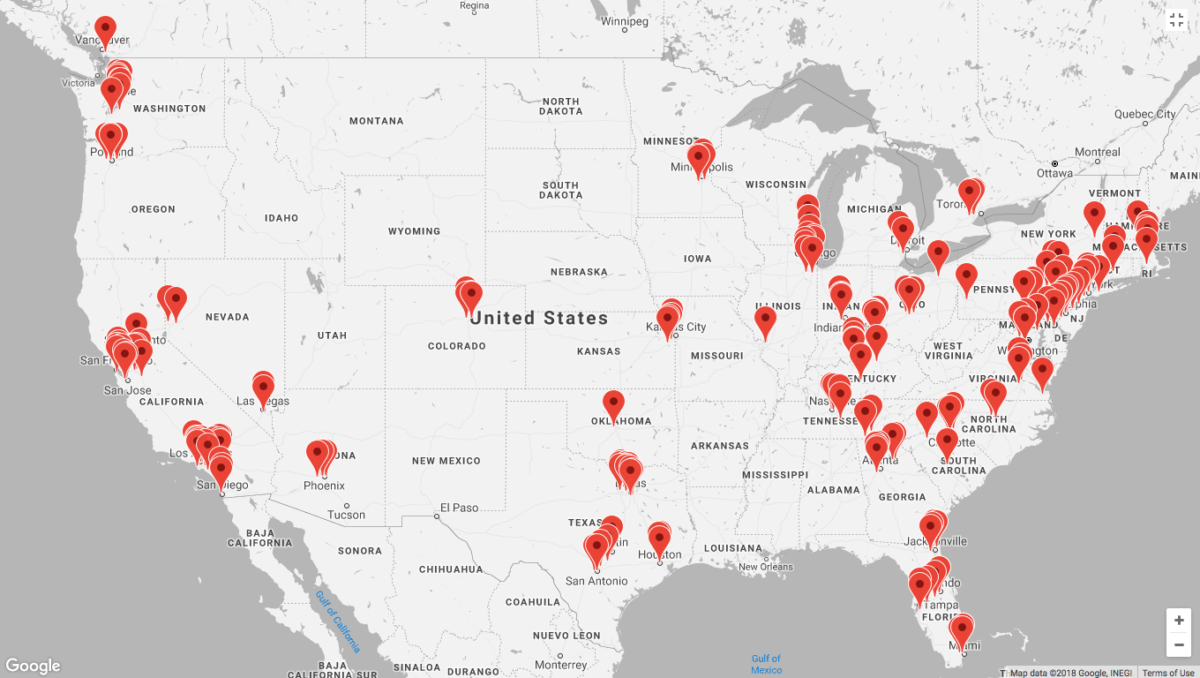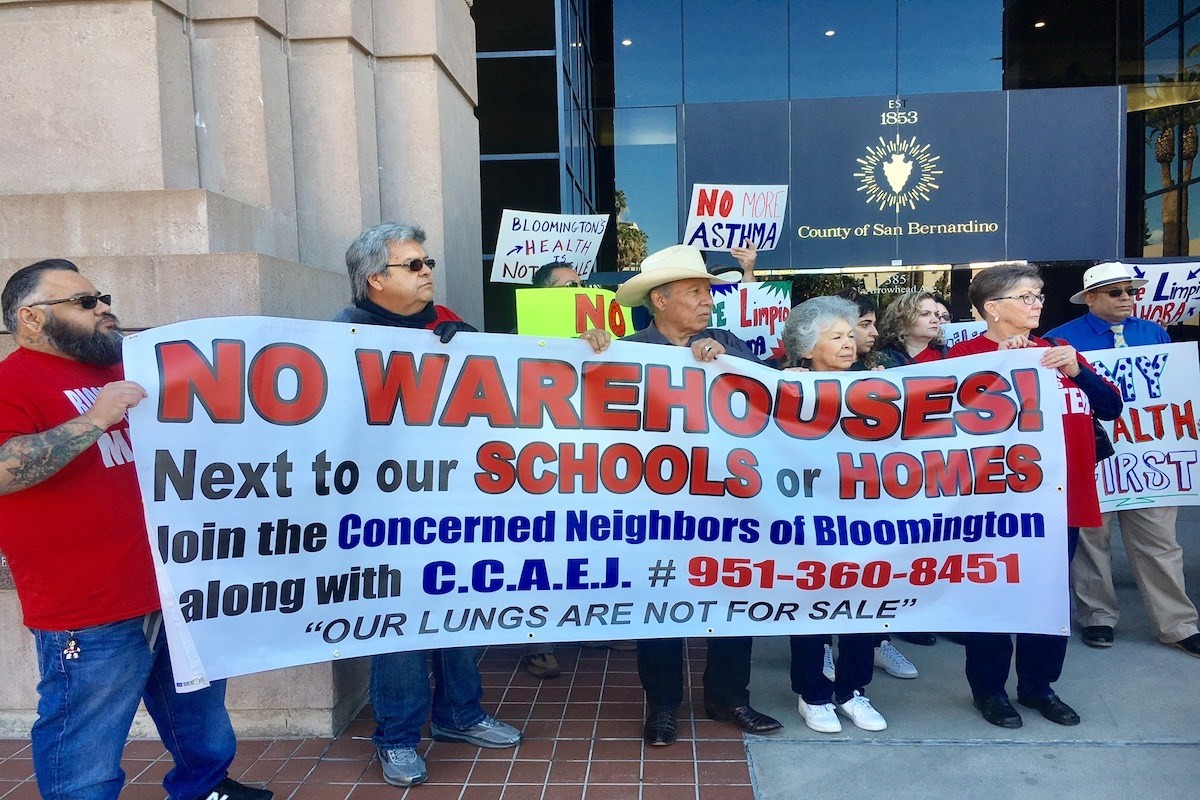Amazon, long known for its low pay and bad labor practices at the company’s fulfillment centers, is starting to feel some heat. One of the largest trade unions in the United Kingdom, GMB, is staging ongoing protests, the SEIU has launched a “Warehouse Workers Stand Up” campaign in New Jersey and Sen. Bernie Sanders has introduced the Stop BEZOS Act. The legislation would recapture the hundreds of billions of taxpayer dollars provided by the US Treasury for health coverage, food stamps and other government payments to Amazon workers.
But Amazon is also wreaking havoc on the environment, and its delivery vehicles are generating untold amounts of greenhouse gases, ozone and particulate matter. California environmental advocates are taking on this challenge to protect the air quality in communities living with these warehouses in their backyards.
The US alone has more than 124 million square feet of fulfillment centers already built and another 41 million square feet in the planning stages, according to logistics industry trade publication MWPVL. Amazon is expanding its footprint at the expense of communities already overburdened by pollution and traffic of the dirty diesel trucks that move goods to and from the centers. From New Jersey to California, Amazon warehouses are remaking the physical environment.

As the real estate boom in California drives gentrification and displacement to even more remote suburbs, communities on the periphery that are already burdened by toxic landfills and pesticide-driven agriculture are battling a new source of poisoned air and water: warehouse distribution centers.
California is home to 18 of Amazon’s huge distribution complexes. The newest is the 855,000-square-foot facility in Fresno, a town located about halfway between Los Angeles and the San Francisco Bay area. One of the top three, coming at over 1.1 million-square-feet, is a facility built in San Bernardino County in 2016, directly east of Los Angeles.
The stakes are high for California’s once-rural suburbs. Life expectancy in West Fresno is more than 20 years lower than in the unpolluted East Side neighborhoods. The Inland Empire, which includes San Bernardino, has some of the worst ozone pollution in the country, according to the American Lung Association, and it has worsened over the last two years. Things have gotten so bad that Southern California’s South Coast Air Quality Management District voted in May to regulate warehouses as indirect sources of pollution because of the truck and locomotive traffic they attract.

Two California residents — Leo Macias and Dania De Ramon — both say they have experienced firsthand the impact of Amazon’s expanding footprint. Macias, who has owned a home in Fresno since 1967, describes the high rates of cancer he has observed on his street. De Ramon, a high school student in San Bernardino County, describes the widespread respiratory problems afflicting her classmates.
“Two of my family members have developed cancer, I have cancer, asthma and a lot of other respiratory problems,” said Macias. “My neighbors right next door to me passed away due to cancer, and another two neighbors on the other side. Yeah, this is very hard for us because we’re dealing with a lot of [contamination] in the air, in the water, in the soil, everything.”
De Ramon feels similarly frustrated. “We live in a toxic cycle where we depend on a supply and logistics industry that does little to curb its emissions and exploits folks in low-income communities for low pay. Most of us don’t even realize the harmful impacts on our health. I grew up believing that asthma was normal because I had so many classmates who had it,” De Ramon said.
Ashley Werner, senior attorney with Fresno-based Leadership Counsel for Justice and Accountability echoes these concerns. “It’s worth noting that this Fresno neighborhood has been identified under CalEnviroScreen as the most pollution-burdened census tract in California. That’s because, in addition to the new facilities the city is permitting, this area also has several hazardous waste sites, a landfill … and farming that uses hazardous pesticides.”
Macias has been working with the Leadership Counsel to fight locally against a huge expansion of warehouses for unknown new tenants, now planned at over 2 million square feet, but he says, “They want to build with no input from the community. When we talked to the city council, they ignored us and laughed at us.”
Macias and Leadership Counsel decided to take their fight to the Sacramento Legislature and are pushing AB 2447, a bill currently awaiting Gov. Jerry Brown’s signature. AB 2447 would give communities advance notice of developers’ plans to build or expand industrial facilities in environmentally burdened communities.
“In the past year and a half, the City of Fresno has approved millions of square feet of industrial warehouse space across the street from my neighborhood and near our local elementary school,” said Macias in testimony on AB 2447 in Sacramento. “We were never told about these projects while the city was planning them, and now the dust from construction is choking us and triggering our asthma.”
Allen Hernandez, executive director of the Center for Community Action and Environmental Justice, based in Southern California’s Inland Empire region, has also called on Governor Brown to take action. “The trucks that travel to and from warehouses contribute dangerous air emissions which causes more traffic congestion and that means more air and noise pollution near our homes and schools.”
The Center for Community Action and Environmental Justice is leading the fight against a new warehouse that would be built 70 feet away from a residential community and less than a tenth of a mile from a high school in the small town of Bloomington in San Bernardino County.
“The residents of Bloomington demand transportation justice for their health. California must re-shape our land-use planning to promote investments without displacement and move away from a culture that relies on fossil fuels.” said Hernandez.

For De Ramon, air quality isn’t the only impact. “When I was younger, my mother would work two jobs to financially support us,” he said. “Many times her work was in warehouses — where some days she would work up to 16 hours. There was a period of time in my childhood where I would see my mother only for a couple hours a day because she was constantly working to get the two of us by.”
The California Environmental Justice Alliance, a statewide environmental group, is supporting AB 2447 and also calling for much broader change.
“AB 2447 is a crucial first step to addressing long-standing pollution in many low-income neighborhoods and communities of color by creating ‘Green Zones’ — places where community-led visions and solutions are transforming toxic hot spots into healthy neighborhoods,” says Tiffany Eng, Green Zones program manager for the alliance.
The California Environmental Justice Alliance has also released a new report, “Green Zones Across California,” detailing community-led transformations in nine regions of the state. In addition the organization has set up a petition calling for statewide support to encourage Governor Brown to sign the bill.
And of course, all the groups have been turning out their members for the many demonstrations and actions being organized in response to Governor Brown’s Global Climate Action Summit that begins September 12 in San Francisco. The kick-off march Rise for Climate Jobs and Justice drew tens of thousands to the streets of SF and to protests across the US. Educational sessions at multiple locations and direct action at the summit itself are planned for the rest of the week.
Help us Prepare for Trump’s Day One
Trump is busy getting ready for Day One of his presidency – but so is Truthout.
Trump has made it no secret that he is planning a demolition-style attack on both specific communities and democracy as a whole, beginning on his first day in office. With over 25 executive orders and directives queued up for January 20, he’s promised to “launch the largest deportation program in American history,” roll back anti-discrimination protections for transgender students, and implement a “drill, drill, drill” approach to ramp up oil and gas extraction.
Organizations like Truthout are also being threatened by legislation like HR 9495, the “nonprofit killer bill” that would allow the Treasury Secretary to declare any nonprofit a “terrorist-supporting organization” and strip its tax-exempt status without due process. Progressive media like Truthout that has courageously focused on reporting on Israel’s genocide in Gaza are in the bill’s crosshairs.
As journalists, we have a responsibility to look at hard realities and communicate them to you. We hope that you, like us, can use this information to prepare for what’s to come.
And if you feel uncertain about what to do in the face of a second Trump administration, we invite you to be an indispensable part of Truthout’s preparations.
In addition to covering the widespread onslaught of draconian policy, we’re shoring up our resources for what might come next for progressive media: bad-faith lawsuits from far-right ghouls, legislation that seeks to strip us of our ability to receive tax-deductible donations, and further throttling of our reach on social media platforms owned by Trump’s sycophants.
We’re preparing right now for Trump’s Day One: building a brave coalition of movement media; reaching out to the activists, academics, and thinkers we trust to shine a light on the inner workings of authoritarianism; and planning to use journalism as a tool to equip movements to protect the people, lands, and principles most vulnerable to Trump’s destruction.
We’re asking all of our readers to start a monthly donation or make a one-time donation – as a commitment to stand with us on day one of Trump’s presidency, and every day after that, as we produce journalism that combats authoritarianism, censorship, injustice, and misinformation. You’re an essential part of our future – please join the movement by making a tax-deductible donation today.
If you have the means to make a substantial gift, please dig deep during this critical time!
With gratitude and resolve,
Maya, Negin, Saima, and Ziggy
